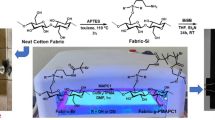Abstract
The phosphorus-containing acrylate monomer, 2-acryloyloxyethyl diethyl phosphate (ADEP), was synthesized and applied to cotton fabric by using the admicellar polymerization technique. A cationic surfactant (cetylpyridinium chloride, CPC) was used as the surfactant for admicellar polymerization. Results from FTIR-ATR and SEM showed that PADEP polymer film was successfully formed on the cotton fabric surface. TGA and DTG analyses showed that the phosphorus-containing PADEP lowered the decomposition temperature of the treated fabric resulting in a higher char yield than in the case of untreated cotton. The flammability tests showed that PADEP-coated cotton with the phosphorus content 4.18 mg/g cotton was self-extinguishing, with the flame extinguishing right after the removal of the ignition source leaving a small area of char formation.







Similar content being viewed by others
References
Bajaj P (2000) Heat and flame protection. In: Horrocks AR, Anand SC (eds) Handbook of technical textiles. The Textile Institute, UK
Bajaj P, Sengupta AK (1992) Protective clothing. Text Prog 22(2/3/4):1–100
Boufi S, Gandini A (2002) Formation of polymeric films on cellulosic surfaces by admiceller polymerization. Cellulose 8:303–312
Davies PJ, Horrocks AR, Alderson A (2005) The sensitisation of thermal decomposition of ammonium polyphosphate by selected metal ions and their potential for improved cotton fabric flame retardancy. Polym Degrad Stab 88:114–122
Fire Statistics (1991) UK Home Office (1993), London, UK
Fire in the United Stated (1982) The United States fire administration, 4th edn. Federal Emergency Management Agency, Washington, DC
Gaan S, Sun G (2007) Effect of phosphorus and nitrogen on flame retardant cellulose: a study of phosphorus compounds. J Anal Appl Pyrol 78:371–377
Grancaric AM, Pusic T, Soljacic I, Ribitsch V (1997) Influence of electrokinetic potential on adsorption of cationic surfactants. Text Chem Color 29:33–35
Harwell JH, O’Rear EA (1988) U.S. Patent No. 4,770,906
Hendrix JE, Bostic JE, Olson ES, Barker RH (1970) Pyrolysis and combustion of cellulose. I. Effects of triphenyl phosphate in the presence of nitrogenous bases. J Appl Polym Sci 14:1701–1723
Horrocks AR (1983) An introduction to the burning behavior of cellulosic fibres. J Soc Dyers Color 99:191–197
Lai CH, Harwell JH, O’Rear EA, Komatsuzaki S, Arai J, Nakakawaji T, Ito Y (1995) Formation of poly(tetrafluoroethylene) thin films on alumina by admicellar polymerization. Langmuir 11:905–911
Lekpittaya P, Yanumet N, Grady BP, O’Rear EA (2004) Resistivity of conductive polymer-coated fabric. J Appl Polym Sci 92:2629–2636
Lewin M (2005) Unsolved problems and unanswered questions in flame retardance of polymers. Polym Degrad Stab 88:13–19
Methachan B, Pongprayoon T, Yanumet N (2002) Formation of hydrophobic cotton fabric by admicellar polymerization. AATCC Rev 2:60–64
Pongprayoon T, Yanumet N, O’Rear EA (2002) Admicellar polymerization of styrene on cotton. J Colloid Interface Sci 249:227–234
Ren X, Kou L, Kocer HB, Zhu C, Worley SD, Broughton RM, Hwuang TS (2008) Antimicrobial coating of an N-Halomine biocidal monomer on cotton fibers via admicellar polymerization. Colloids Surf A 317:711–716
Siriviriyanun A, Yanumet N, O’Rear EA (2007a) Modification of polyester fabric properties by surfactant-aided surface polymerization. J Appl Polym Sci 103:4059–4064
Siriviriyanun A, Yanumet N, O’Rear EA (2007b) Improvement in the flame retardancy of cotton fabric by admicellar polymerization of 2-acryloyloxyethyl diethyl phosphate using an anionic surfactant (submitted)
Tesoro G (1976) Current research on chemical modification of cellulose. Pure Appl Chem 46:239–245
The American Society for Testing and Materials, ASTM D 1230-94 (Reapproved 2001) Standard test method for flammability of apparel textiles
Wu W, Yang CQ (2004) Statistical analysis of the performance of the flame retardant finishing system consisting of a hydroxy-functional organophosphorus oligomer and the mixture of DMDHEU and melamine–formaldehyde resin. Polym Degrad Stab 85:623–632
Yuan WL, O’Rear EA, Grady BP, Glatzhofer DT (2002) Nanometer-thick poly(pyrrole) films formed by admicellar polymerization under conditions of depleting adsolubilization. Langmuir 18:3343–3351
Acknowledgments
Ampornphan Siriviriyanun gratefully acknowledges the scholarship provided by the Thailand Research Fund (TRF-RGJ Program) and The Petroleum and Petrochemical College. The authors would also like to acknowledge the financial support from the Research, Development and Engineering Fund through National Nanotechnology Center, National Science and Technology Development Agency, Thailand (Project No. NN-B-22-CT4-10-50-09). Additional support from National Excellence Center in Petroleum, Petrochemical, and Advanced Materials is also gratefully acknowledged. Special thanks also go to Asst. Prof. Sireerat Charuchinda and Mr. Rutchapong Horthimaworrakorn at the Department of Materials Science, Faculty of Science, Chulalongkorn University, for their assistance in the flammability tests.
Author information
Authors and Affiliations
Corresponding author
Rights and permissions
About this article
Cite this article
Siriviriyanun, A., O’Rear, E.A. & Yanumet, N. Self-extinguishing cotton fabric with minimal phosphorus deposition. Cellulose 15, 731–737 (2008). https://doi.org/10.1007/s10570-008-9223-7
Received:
Accepted:
Published:
Issue Date:
DOI: https://doi.org/10.1007/s10570-008-9223-7




